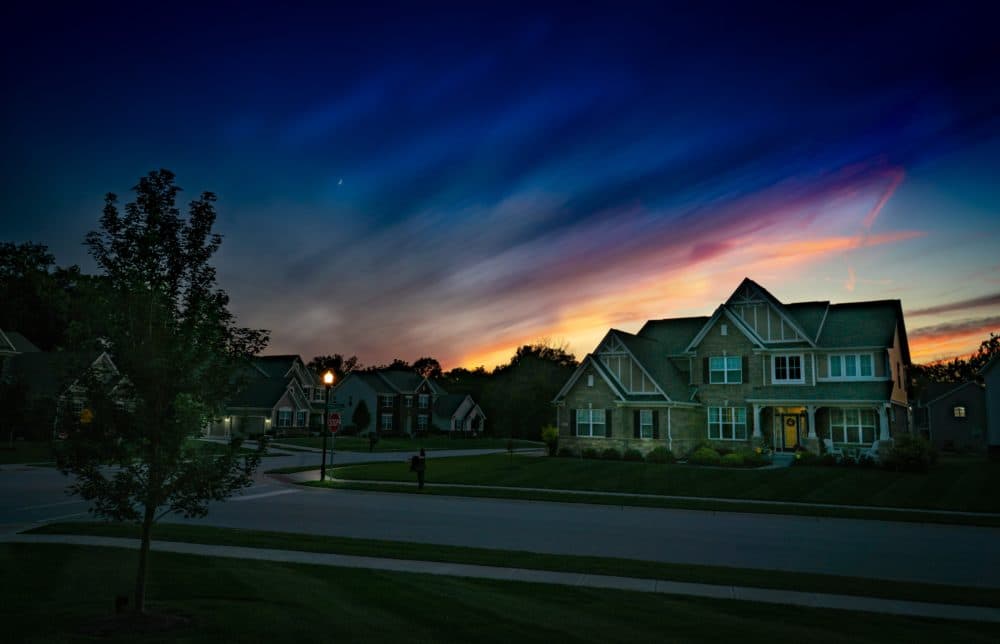Advertisement
Commentary
Trump's ‘Suburban Lifestyle Dream’ Is Real: Just Look At Greater Boston’s Housing Plans

The arc of the moral universe bends along the quiet residential roads of Greater Boston.
It curves through Reading, a railroad suburb on Route 128, described in its 2005 town plan as “a daily refuge from the pressures, impersonality, and uncertainties of modern urban life.” According to the plan, Reading’s residents judge changes to the town against their ideal image of Reading “as a peaceable, family-oriented, single-family suburban residential community.”
Reading’s residents are not alone in their bias for single-family houses. The vast majority of land in Boston’s suburbs is zoned for and built with single-family housing. The tiny islands and narrow peninsulas of land zoned for multi-family housing are generally built out to the capacity allowed. Suburban decisionmakers, overwhelmingly owners of single-family houses, allow new apartments on a project-by-project basis, often on the edge of town, isolated between train tracks, highways and water. The region largely outlaws what so many non-homeowners want — apartments within walking distance of village hubs.
Throughout the region, homeowners unite to protect their neighborhoods from change. They set forth objectives like Reading’s: “Preserve the town as a primarily single-family, owner-occupied residential community” and adopt laws to advance the cause.
The region largely outlaws what so many non-homeowners want -- apartments within walking distance of village hubs.
The objective can be found in one local plan after another, like Wellesley’s 2017 draft plan, “Preserve the character of single-family streets,” and Burlington’s 2017 draft plan: “For any comprehensive housing policy to work in Burlington, it must begin with protecting the town’s single-family neighborhoods from unwanted encroachment by other land uses.” The next sentence clarifies that “other land uses” means multi-family housing.
It is an old issue, as old as zoning, which became common in the 1920s. In its famous 1926 pro-zoning decision, the Supreme Court referred to apartment houses as “a mere parasite, constructed in order to take advantage of the open spaces and attractive surroundings created by the residential character of the district.”
The heart of the matter is even older than zoning, and older than single-family houses. It is a conflict rooted deep in civilization, ancient like the walls of Jerusalem, and surely older than the Bible’s multiple commandments to love the stranger.
The world is dangerous, and people are fragile, made of soft flesh, little bones and anxious minds. The central tasks of civilization include creating safe, stable places for human flourishing. The walls of houses and walls of cities and borders of states have risen for the safety of families and communities.
Now, many suburban villagers, here today, have found themselves in what feels like a “refuge from the uncertainties of life.” And just as fortuitously for them, their suburban havens are pretty collages of brick and wood, pediments and porticos, walkways and daylilies, and tall canopies of maple and oak — the labor of generations. Today’s suburbanites are reinforcing neighborhood boundaries with paper walls of regulation, to keep out the stranger, stop change and preserve the pleasing views. It is relatable that suburban denizens plead, “Do not screw this up for us.”
But the use of public laws to secure neighborhoods and whole towns from change clashes with another core civilizational imperative, the pursuit of justice. It evokes an existential question about America’s purpose, like the one Lin Manuel Miranda’s Hamilton poses: “Burr, we studied and we fought and we killed for the notion of a nation we now get to build.” He asks, “What was it all for?”
“The Suburban Lifestyle Dream,” tweeted the U.S. president recently, in a seeming response. “I am happy to inform all of the people living their Suburban Lifestyle Dream that you will no longer be bothered or financially hurt by having low income housing built in your neighborhood...”
Jarred Johnson of Boston's Transit Matters, tweeted back: “Don't know who needs to hear it, but you need to value Black lives more than home's sale price or ‘neighborhood character'.”
Public policies that favor detached single-family houses and owner-occupancy over multifamily housing and renting, without regard for demand, perpetuate racial segregation and undermine social mobility. So do policies that isolate apartment buildings away from village hubs, away from transit, schools, shops and parks.
In 2015, the Boston Fed reported that the median wealth of white households in Greater Boston was $247,500, while that of Blacks was close to zero. Nearly 80% of whites in the region owned a home, whereas only one-third of Black and less than one-fifth of Dominican and Puerto Ricans were homeowners. Suburban aversion to rental housing, as translated into laws, has effectively limited opportunities for minorities who lack down-payments from moving to the suburbs.
Exclusionary zoning policies exacerbate the injustices of racism and Black disadvantage, which are rooted in slavery and Jim Crow and still pervasive in all aspects of American life, including housing, education, employment, health care and criminal justice.
In the era of “white flight” from cities like Boston to the suburbs, discrimination from mortgage lenders and realtors limited opportunities for Blacks to establish homes in the suburbs; companies relocated from cities to suburban office parks accessible only by car, an amenity many Blacks could not afford; and the suburbs systematically down-zoned — increasing minimum lot sizes and eliminating much of the zoning for apartments.
The Town of Wayland’s 1962 Master Plan is unapologetic about the exclusionary downzoning. In response to population pressure, Wayland's Planning Board and Town Meeting appraised Wayland’s position among the suburbs and then acted to maintain Wayland’s single-family-only zoning while increasing the lot area and frontage needed to build single-family houses. “These policies are primarily responsible for the growth of Wayland in a manner that has encouraged investment in homes and gives evidence of creating a most satisfactory environment for family living,” the 1962 plan reads.
Decades later, Wayland’s 2016 housing plan reiterates the sentiment: “Within existing residential neighborhoods, new multi-family housing is generally not recommended because of concerns that it would alter the single-family character of most of Wayland’s neighborhoods.” In 2017, Wayland residents opposing proposed apartments began a “Stop the Monster” campaign posting lawn signs depicting a cartoon apartment building with large eyes and teeth that might get Grandma to say, “My, what sharp teeth you have.”
Apartment buildings will not devour the charm and safety of Greater Boston for dinner. Apartments are homes, and people need homes. Homeowners and renters alike can and should reform housing policies and zoning — for the core American values of justice, equal opportunity and social mobility. Through better regulation, suburbs can preserve both the visual character of neighborhoods and Greater Boston’s moral character.
